If you buy through our links, we may earn an affiliate commission. This supports our mission to get more people active and outside.Learn about Outside Online's affiliate link policy
Best Outdoor Bluetooth Speakers for Bringing the Party with You

(Photo: Grace Palmer)
Table of Contents
We’ve appreciated several innovative trends in the best outdoor Bluetooth speakers this year: “True stereo,” which lets you pair two speakers at once and play the left channel in one and the right in the other, is available in more and more models. While it may be a clever way of selling you two speakers instead of one, it makes the experience more like sitting in front of your home hi-fi system. Meanwhile, battery life keeps on improving across the board, and it’s kind of stunning how water-resistant these devices have become: All of the speakers we tested have an ingress rating of at least IP57, which means they can be submerged in three feet of water for up to 30 minutes. If you’ve ever combined a swimming hole and a large dog in the same outing, you know why this matters. All of these upgrades make the new speakers highlighted here some of the best ever for your adventures. After 790 total hours of testing this year, we’ve narrowed down the best Bluetooth speakers for outdoors, depending on your needs and budget.
Update November 2025: This fall we’ve singled out two excellent, super-rugged Bluetooth speakers and added a new pick for “Most Portable.” Plus, we’ve updated prices and availability for all. The Brane X holds on to its spot as the best all-around.
Best Outdoor Bluetooth Speakers: At a Glance
- Best Outdoor Bluetooth Speaker Overall: Brane X ($499)
- Best Value: Fender x Teufel Rockster Go 2 ($90)
- Most Portable: Sony ULT Field 5 ($230)
- Most Rugged: Turtlebox Grande ($730)
- Best for Audiophiles: Bose SoundLink Max ($399)
- Best Mini Speaker: Ultimate Ears Miniroll ($60)
- Best for Parties: EcoXgear Defender ($299)
- Best for Travel: Marshall Emberton III ($150)

Best Outdoor Bluetooth Speaker Overall
Brane X
Pros and Cons
+ More bass than you’ll believe possible
+ Wi-Fi connectivity
– Makes funny noises on startup
– Touch controls are overly sensitive
It’s rare that a product has so much crossover appeal that it’s nearly impossible to categorize—labels be damned. The Brane X is an ingenious piece of technology that transitions neatly from a bookshelf-style speaker for your desktop to a backyard DJ boom box to a travel companion for a remote lakeshore, where, as one tester said, it produces bass that can “scare away the bears.” This versatility and its surprising power are what led our team to name it the best outdoor Bluetooth speaker we tested.
The reason this 7.7-pound unit has such outsize power is magnets. Specifically, it’s the first Bluetooth speaker with a subwoofer, which relies on a Repel-Attract Driver (RAD), a patented technology that employs specially designed magnets that cancel internal air pressure and allow it to produce deeper bass than was previously possible.
In practice, the results are impressive: Played at lower volumes, it produces fine detail that is as good as anything that comes out of a Bose product. But when you pump up the volume, you can hear bass notes that reach lower into the audio spectrum. It’s safe to say nothing we’ve seen at this size (under ten inches wide) has been able to create such a rumble way down deep in your belly.
The Brane X can connect with your home Wi-Fi, eliminating the problem of your Bluetooth speaker glitching out during a party because you stepped outside to fetch ice. This feature also makes streaming music over a subscription service or using the built-in Alexa voice assistant easier and more reliable.
And yes, despite its urban looks, the Brane X can withstand water, dust, and a fair bit of rough handling: Its IP57 rating means it can survive in three feet of water for up to 30 minutes. A 12-hour battery life is respectable, given its power. And the Brane app makes it easy to set up and equalize, for less bass, more bass, or more more more bass. Listening to jazz with a double bass, one user said, “you can hear all the subtle squeaks of the player’s fingers on the strings.”
If there’s a drawback to a speaker this good, it would only be that it makes the windows rattle. Said one tester: “It makes other portable speakers seem like toys.”
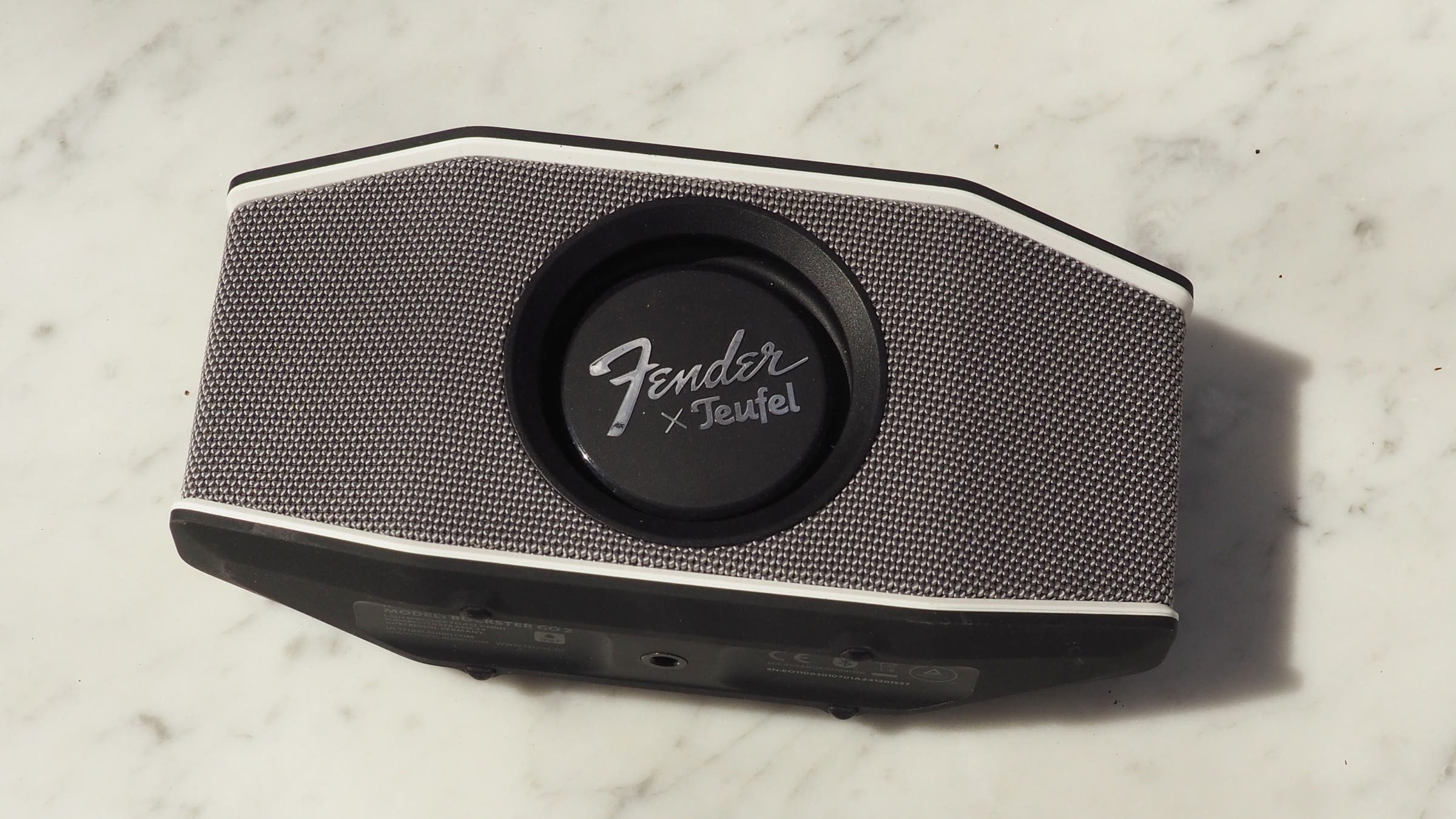
Best Value
Fender x Teufel Rockster Go 2
Pros and Cons
+ Sound fills the room
+ Long battery life
– Controls not all in same place
The German audio engineers at Teuful got together with the American guitar and amp brand Fender to make this thing of beauty. The sleekly designed Rockster Go 2 is smaller than a hardcover airport novel, at eight by four inches, but it pumps out some of the best, bassiest sound in this size range. Much like Bose’s SoundLink Flex—whose latest version weighs in at 1.3 pounds and costs $149—the 1.6-pound Rockster Go 2 amazed us with its “straight-ahead sound quality and musical vividness,” as one tester put it. It goes one step further than Bose with a button that engages what’s called Dynamore virtual stereo sound, an impressive, non-gimmicky feature that seems to magically move the music to the corners of the room. The speaker is unidirectional, but the Dynamore feature does a lot to make it sound good from the front or the back.
The Rockster Go 2 is supposed to last for up to a whopping 28 hours in Eco Mode (which reduces the bass), though you’ll probably get more like the 15 hours it promises in regular mode at medium volume. Quick charging, however, gets you out the door faster if you forgot to plug it in the night before. A short carry strap enables easier toting, and GoPro users will appreciate the quarter-inch threading on the base, which is compatible with camera mounts. Although its range is only 30 feet, one reviewer remarked that “with a design that’s worthy of residing on your bookcase plus its rugged build, this may be the ideal indoor/outdoor speaker in the midsize range.”
Note: The Rockster line includes two other, larger sizes: the $180 Rockster Cross and the monster $480 Rockster Air 2.
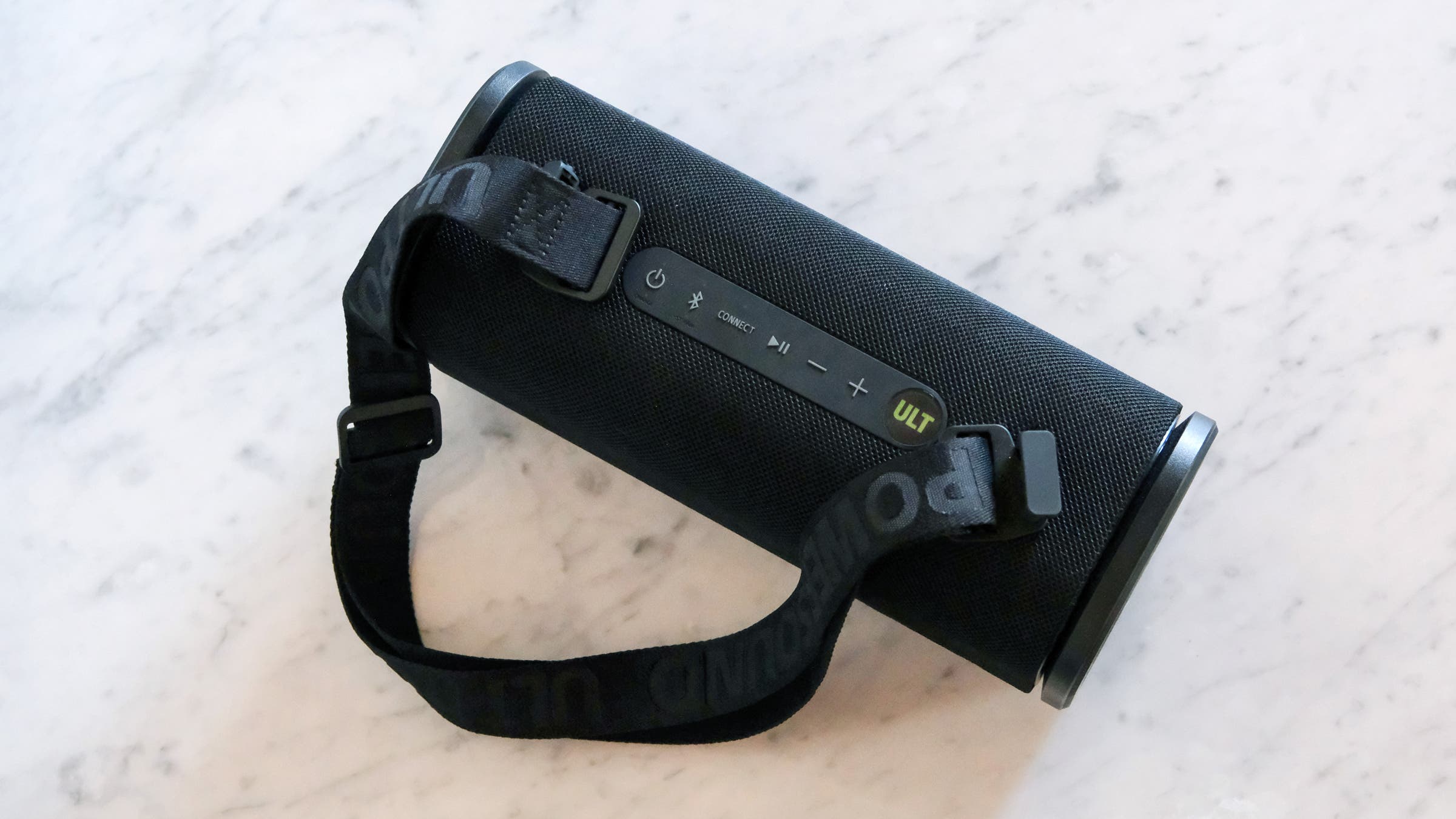
Most Portable
Sony ULT Field 5
Pros and Cons
+ Indoor-outdoor crossover appeal
+ Well-balanced sound
+ Tasteful classic Sony design
– Bass not as strong as others
“The Goldilocks of sound, portability, and fun” is how one of our test team described the ULT Field 5. Portable, because it has a detachable shoulder strap that repeatedly invited users to pick it up and take it with them. And fun, thanks to an understated LED light show of dark neon hues that you can switch off when you’ve had enough.
But it’s the acoustics that make the Field 5 shine. Much like the Bose SoundLink Max we tested, this outdoor speaker has an immediacy and richness that make it well suited for hip-hop, classical, and anything in between. Listening to a track like Fleetwood Mac’s “Sara,” the crisp guitars, steady bass and drums, and Stevie Nicks’s vocals all come across in perfect balance. “The sound won’t shock fish into floating to the surface of the lake,” one tester said, “but it’s plenty for most applications and blows away smaller speakers.”
From the outside, the Field 5 looks like a handsome bookshelf speaker, with a cloth surface and sleek design. But it has more travel potential than you’d first assume, including an IP67 rating that matches the Turtlebox and EcoXgear models we tested. It wouldn’t fare as well falling off your pickup at 80 miles an hour, but it’s just as capable of handling water—although it won’t float, so don’t get carried away.
Soft rubber buttons on the top panel are intuitive, and the built-in ULT equalizer toggles between normal sound, extra bass, and what Sony describes as “a sense of increased power.” Other tech bonuses are found on the Sound Connect app, one of the best in the game, which allows you to set up your own EQ and fiddle with DJ sound effects. The Field 5 also reads memory sticks—“great news for those bypassing streaming services,” said one tester.
The 25 hours of battery life are adequate, and a 10-minute quick charge adds up to two hours of playtime. Two ULT Fields can be linked together (this includes the smaller Field 1 and Field 3 and the larger Field 7). And while it’s 23 percent heavier than the Bose SoundLink Max (at 7.3 pounds), the Field 5 is only two inches longer (at one foot). Which, along with that very useful shoulder strap, makes this a good alternative to the Bose model, at $70 less.

Most Rugged
Turtlebox Grande
Pros and Cons
+ Sounds fantastic at any volume
+ Rugged AF
– No companion app
– The price
Weighing in at nearly 19 pounds, with a teeth-rattling capacity for booming bass, the Turtlebox Grande immediately makes its presence known. In fact, like the Brane X, it’s the rare outdoor Bluetooth speaker that can play tracks with the most cavernous bass—extremely loudly, without distortion, and while retaining rich detail in the higher ranges. The original Turtlebox became a sensation among fishermen and off-roaders for its backcountry capabilities, and the Grande ups the ante: should you be shopping for a sound system to outfit your new monster truck, this is it.
At 126 decibels max volume, the Grande doesn’t get much louder than the original Turtlebox (or the ExoXgear Defender, below), but with its 10-inch woofer and a pair of digital amplifiers, it sounds better at low volumes while hardly ever causing any distortion at high ones. “Heavy rock sounds especially good,” one tester observed.
The Grande is housed in the same super-hard plastic as the OG Turtlebox and is IP67 dustproof, submersible, and floatable. It can be synced together with a second Turtlebox model to produce True Wireless Stereo or, in Party Mode, with an unlimited number of other Turtleboxes. The audio mount in the base lets you elevate it on a speaker stand, and playtime is an amazing 40 hours per charge at moderate volumes.
Testers didn’t have many complaints, though one was annoyed by the lack of a play/pause button, and, considering the price tag, it’s surprising that Turtlebox has no companion app to allow fine-tuning. But maybe that’s part of its brute-force image: indoor modes and programmable controls are for wimps.
With so many great outdoor Bluetooth speakers available for less than half the price, it does take a certain kind of devotion to splurge on this one. As one reviewer noted, the Grande “is overkill for more everyday applications like going to the beach, where you don’t need your music to blow away your neighbors.” But if you’re in the back of beyond where no one can hear you crank up the Johnny Cash and sing along, the Grande combines serious durability and simply great sound.
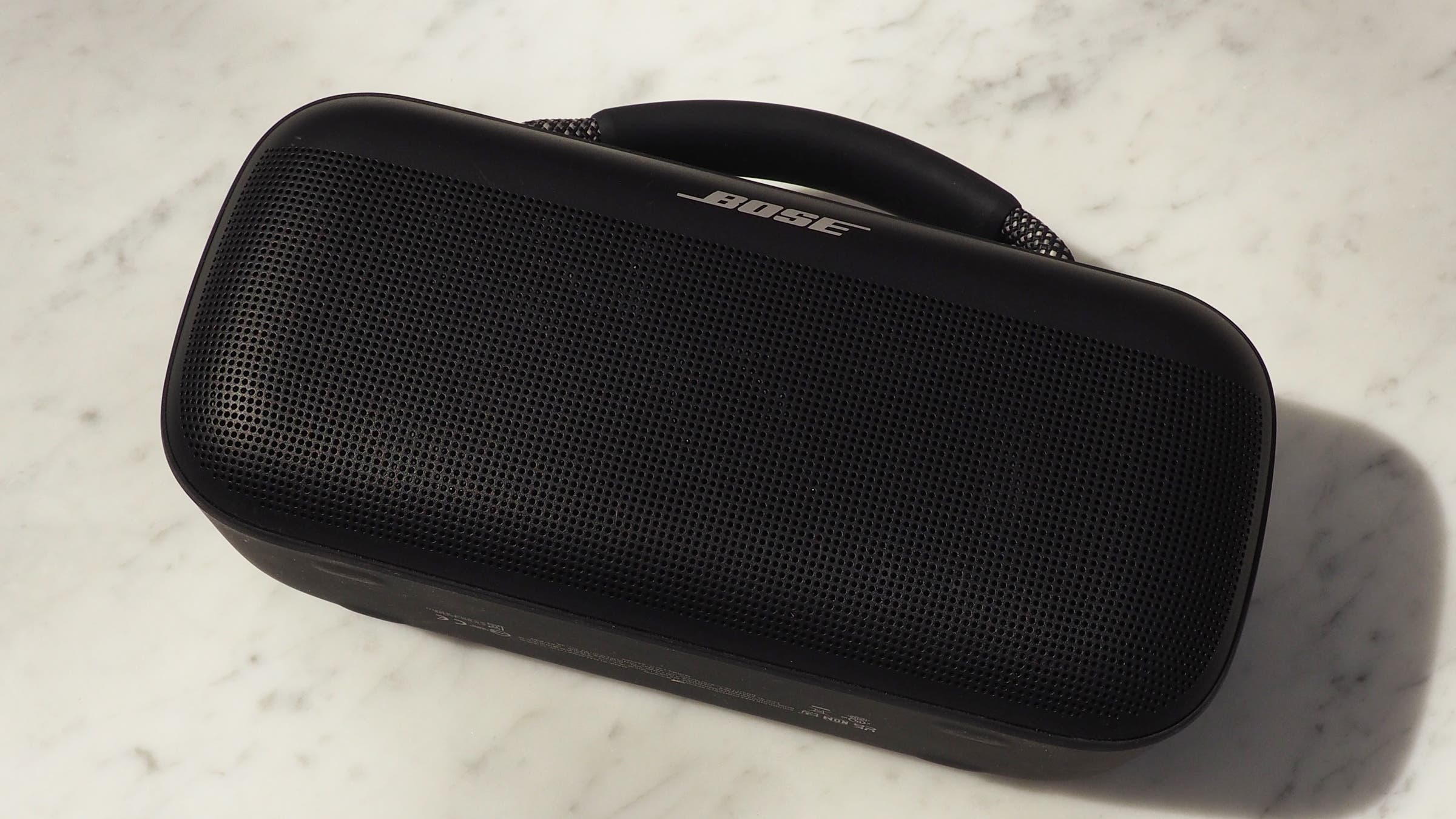
Best for Audiophiles
Bose SoundLink Max
Pros and Cons
+ Very rich, loud sound
+ Long battery life
+ Easy to pair
– Needs 5-volt charger; standard USB-C is slow
For those who were wowed by Bose’s 1.3-pound SoundLink Flex (our 2022 Editor’s Choice winner), this larger and far more powerful 4.9-pound edition of the SoundLink will be true love. It punches above its weight, with rich bass and perfect balance in the higher registers. While the addition of a rubber-coated rope handle is both convenient and cute, the sticking-to-basics features from this classic brand made it a bit less fun than other party-ready units in this test. Where Bose beats them, though, is with more subtle orchestral and ambient tracks. Max Richter’s The New Four Seasons came through with a dynamism and presence that was a notch above.
Battery life is 20 hours, range is a passable 30 feet, and Bose’s app is more versatile than those that accompany most speakers, with EQ settings to suit your tastes and listening environment. IP67 water and dust resistance means it’s fine being dropped in the pool for up to 30 minutes. The SoundLink Max does cost a lot for its size, but for those among us who like to just sit and focus on great music, it may be the most ideal—and ideally sized—portable Bluetooth speaker to date.
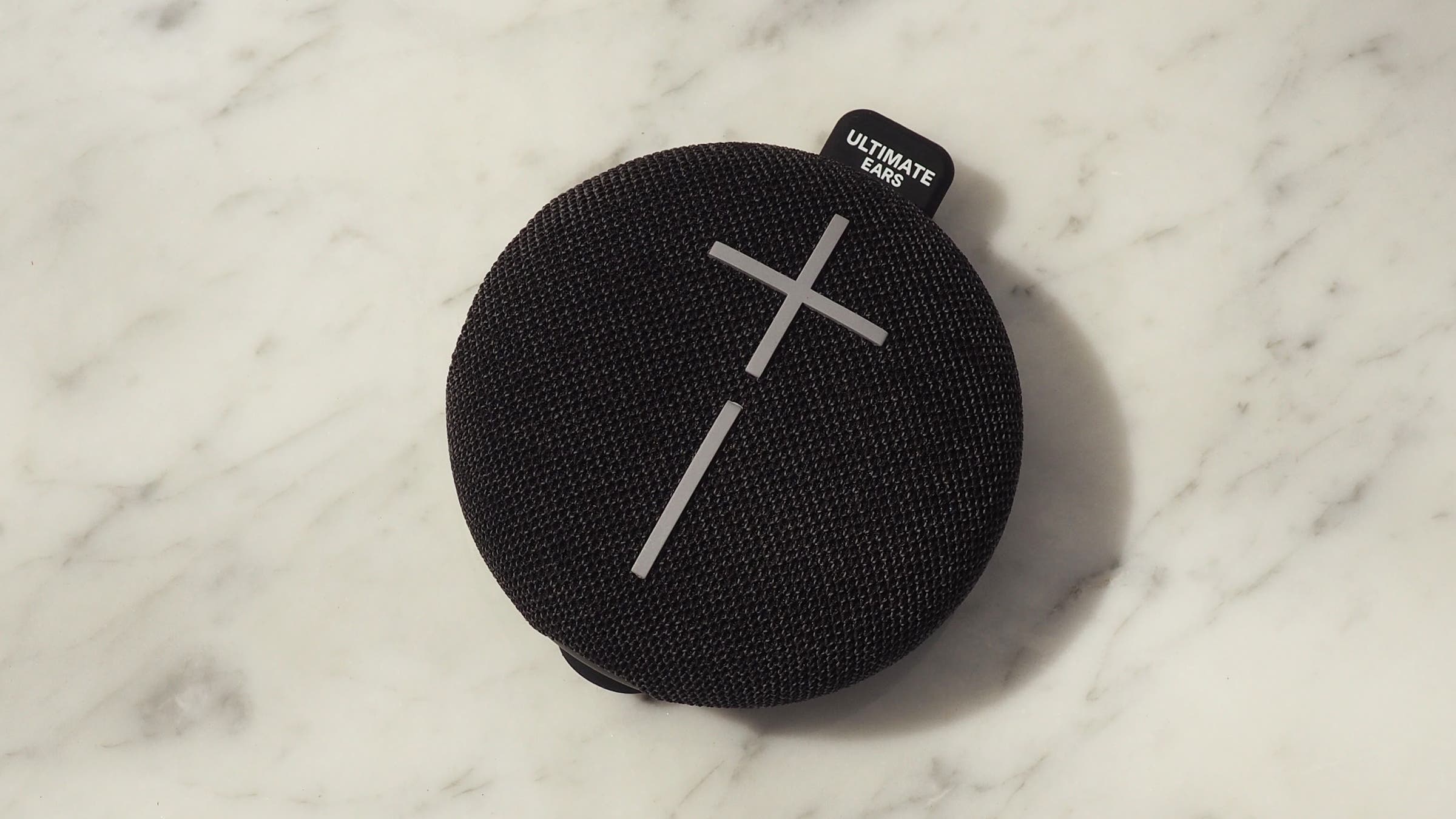
Best Mini Speaker
Ultimate Ears Miniroll
Pros and Cons
+ Very compact
+ Impressive sound for its size
+ Bungee strap is useful
– Can get only so loud
Over the past decade, the “mini speaker” category has been relentlessly trying to reach a level of sonic quality that sounds so much better than your laptop speaker that it warrants a purchase. With the Miniroll, we may have achieved the singularity. At less than 10 ounces and a fits-in-your-hand five-inch diameter, this grab-and-go disc produced some moments of startling loudness for its size. Physics wouldn’t allow it to be in the same acoustic class as the others in this test, but testers were impressed by what it can do.
Think of the places it can go: With its eminently handy built-in rubber strap, the Miniroll can bungee right over your bike handlebars, onto your belt loop, or—a habit I’ve acquired solely on account of this portable Bluetooth speaker—over the shower curtain rod, so I can keep clean while keeping up with the news. As secure as the strap is, a bouncy bike ride might eventually dislodge it, but with its sturdy build, we wouldn’t be too concerned about damage—and its crazy-long range of 131 feet means you won’t lose connection when you turn around to retrieve it. A PartyUp feature lets you pair multiple Minirolls together for more power or a stereo effect.
Anyone debating whether to pack a speaker for an overseas flight or strap it to a backpack for playing podcasts on a hike can be confident that the Miniroll, with its “road-friendly size and shape,” is well worth the consideration.
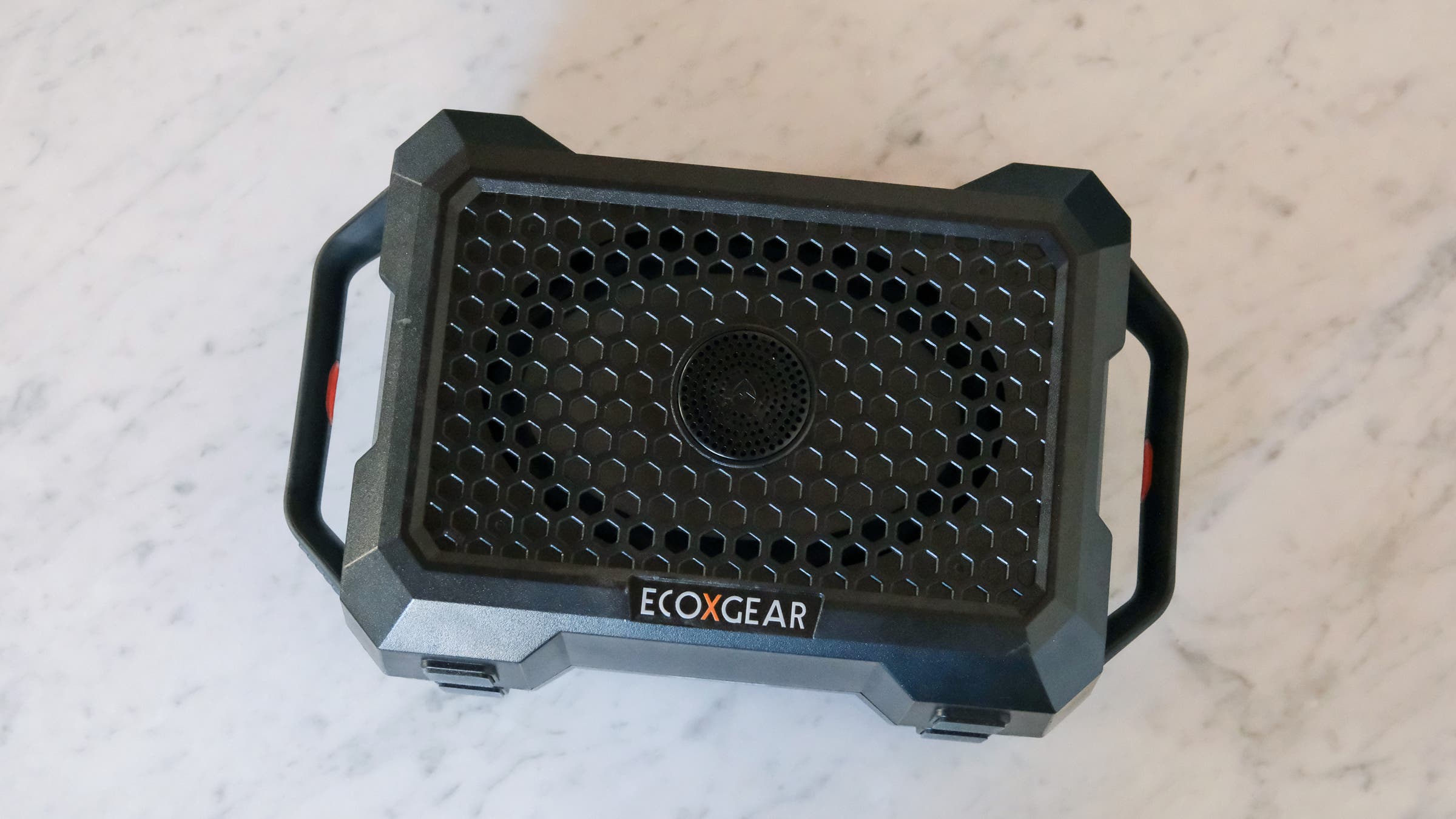
Best for Parties
EcoXgear Defender
Pros and Cons
+ Lots of volume for its size
+ Useful bells and whistles
– Bass can be overwhelming
– Changing EQ modes pauses music for too long
You may be wondering, “Why would I need my speaker to have multicolored LED light sequences, a flashlight, and a bottle opener?” The obvious answer: for hosting a dance party in your backyard or on that houseboat you rented at the lake, naturally.
Since boats and glass bottles don’t mix well, our one tester with boat access dinged the bottle opener, which is, after all, awkwardly placed near the base of the unit. But the powerful flashlight does come in handy if you misplace your keys at the campground or if someone loses an earring on the dance floor. As for the frenetic programmable light show? “I soon found myself mesmerized,” said one reviewer.
But what really made this our favorite party speaker of the year is its ability to play loud enough to keep a few dozen people grooving through the night, with booming bass and nice-and-clear illuminated controls on the top panel (including play/pause and volume). At max volume, the battery is rated for six hours of playtime, but this is a very loud speaker and you won’t need to crank it all the way up; at lower volumes it can go for up to 25 hours. If your party devolves into karaoke, EcoXgear sells a $20 mic that plugs right into the unit.
An “EQ” button on the top panel toggles between indoor, outdoor, and default modes—but while testers appreciated the indoor/outdoor difference, the sound profile on all three is strongly bass-heavy, and the EcoXgear app doesn’t have a way to dial it down. If you have two Defenders, a 2025 update allows them to join together for true left/right stereo, allowing for more balanced sound at a moderate volume. In fact, up to 100 Defenders can be linked together and arranged up to 30 feet apart from one another. If your party is that big, people must really like you.
With its IP67 rating, the Defender shuns mud and dust and can be dunked a meter underwater for up to 30 minutes, although it will just rise to the surface and stay there, pumping out the tunes. Just like the higher-priced original Turtlebox that clearly inspired it, the Defender weighs 10 pounds and is clad in hard plastic that can take a real beating: YouTube is full of users validating their toughness by running them over with their four-wheelers.
Some testers complained about the Bluetooth connectivity: while the company claims a 100-foot range, we lost our connection at less than half that. Testers were also frustrated by the lack of a top handle. Instead, the speaker has a pair of side handles, which have holes to allow you to strap the unit down, but make it more awkward to carry around. Still, given its versatility, high-powered sound profile, affordability, and rough-and-tumble cred, one reviewer said that after just one day of testing the Defender, “I began plotting a day at the lake.”

Best for Travel
Marshall Emberton III
Pros and Cons
+ Solid, compact, travel-friendly build
+ Room-filling sound
– No bass/treble controls on unit
Don’t let the throwback looks of the Emberton III fool you: This technology is far from basic. Marshall’s newest travel Bluetooth speaker has better, more robust sound than its predecessors while adding some new features like Bluetooth LE—a more efficient form of Bluetooth that sucks less energy—and Auracast, an incoming technology that will soon have you wirelessly linking several of your speakers and headphones at once, making a connected life more seamless.
The Emberton III is that one piece of gear you’ll wish you’d packed for your family reunion on the lake this summer. You’ll realize this when you go to play home movies on your tablet with its anemic speaker. You’ll hardly notice the Emberton III in your luggage, at a little over six inches from end to end and only 1.5 pounds—three percent of your checked-bag limit. But you’ll notice it when you fire it up, because, in the words of one tester, “this little thing cranks!”
As with other Marshall speakers, the Emberton III achieves a deceptively dynamic sound quality through “True Stereophonic” multi-directional technology, which replicates the experience of being on a soundstage by moving different tones to different areas of the speaker. One tester noticed the “rich bass notes—not much thump, but clean and clear.” And the well-rounded sound is just as good from the back side as the front.
A whopping 32-hour battery life makes it even more travel-friendly, and a 20-minute quick charge provides six more hours of battery life. The range (thanks to the Bluetooth LE addition) is an excellent 100 feet. And an IP67 rating lets you drop it in the drink (up to three feet deep) with no repercussions (although no testers reported trying this).
One tester summed up his report, “I love the retro looks and small package. It makes a cool statement on the shelf but is small enough you can slip it into your pocket on the way out the door.”
How to Choose the Best Outdoor Bluetooth Speaker
When shopping for a new outdoor Bluetooth speaker, your first move is to check its IP (ingress protection) rating to get an idea of how much water and dust resistance it offers; these are typically reliable. Next, think about how much you’ll be carrying it around—between house and backyard, say, or moving from campsite to campsite—and whether you’ll be on foot (carrying a pack or duffel, or not) or on wheels. Then consider what makes sense in terms of weight and dimensions. As a general rule, the heavier a speaker is, the more volume you’ll get out of it, but playing it loud isn’t always a necessity—some of you will be entertaining large groups, but others will just be setting it up for mellow creekside cocktail-hour listening with your partner.
If you’re someone who moves around a lot, a portable Bluetooth speaker with long battery life might also make a difference. These days most new models will play for a good 10 hours or more even at high volume, but some are longer-lasting than others, as detailed in the models reviewed here. Finally, more and more models offer “true stereo” linking, where two or more speakers can be paired to play at once but in stereo; this makes smaller models with this option a little more attractive than before, because if you later decide to invest more, you can give your soundscape an appreciable boost.
Finally, don’t assume that if one of the speakers in this list doesn’t sound great to you, it’s your fault. Different folks have different tastes, and some types of music sound better—or worse—on certain speakers. If you make a purchase and are feeling lukewarm afterwards, keep an eye on your return window and don’t feel guilty if you have to exchange it.
How We Tested Outdoor Bluetooth Speakers
- Hours of Testing in 2025: 790
- Test Environments: Car camping, pool parties, stand-up paddleboarding, yardwork, hikes, movie watching, beaches, construction sites, conference calls, sailing on San Francisco Bay
- Highest Elevation: 10,152 feet, Leadville, Colorado
- Lowest Elevation: 5 feet underwater in Lake Pleasant, Arizona
- Most Listened-To Tracks: Belle and Sebastian: “I Don’t Know What You See in Me,” Childish Gambino: “Lithonia,” D’Angelo: “Shit, Damn, Motherfucker,” Dijon: “Yamaha,” Drugdealer and Kim Bollinger: “Pictures of You,” Fontaines D.C.: “Favourite,” Kenya Grace: “Strangers,” J Dilla: “Workinonit,” Lady Gaga: “Abracadabra,” Magdalena Bay: “Image,” John Martyn: “Sweet Little Mystery,” Cass McCombs: “Brighter!,” Sinead O’Connor: “Feel So Different,” The O’Jays: “Ship Ahoy,” Prince: “Electric Chair,” Spoon: “Wild,” Thunderegg: “Loyola Dream,” Yumi Zouma: “Powder Blue”
The first thing we do with any outdoor Bluetooth speakers is attempt to pair them with our phones without consulting the user manual: The quicker, more intuitive, and easier the sync, the more points scored. Then we put them through hours of testing doing the kinds of things Outside readers do—soaking in remote hot springs, inviting friends over for outdoor dance parties, playing audiobooks while riding a bike, etc.
Our team turns in reports on each product tested, providing a score of 1 to 10 for five different measures: sound quality, pairing and connectivity, fit and comfort, rain and drop protection, and user friendliness. Scores are averaged, with more weight given to sound quality and (knowing our audience) how well they stand up to the elements. Note: Battery life estimates in these reviews are based on manufacturer specs; it’s difficult to confirm those numbers, given the time involved and variances among user habits (different volumes, different uses, different functions enabled). Actual results may be 10 to 20 percent lower, judging from averages experienced in general testing.
Meet Our Lead Tester
Will Palmer has been testing gear for 21 years for Outside, where he was managing editor and copy chief for nine years. Based in Santa Fe, he has been a runner since 1984, and while the mile counts have decreased over the years, he’s kept motivated to head out the door on the hottest, coldest, and wettest days by the opportunity to test the best new products—and to commune with the junipers and piñons.